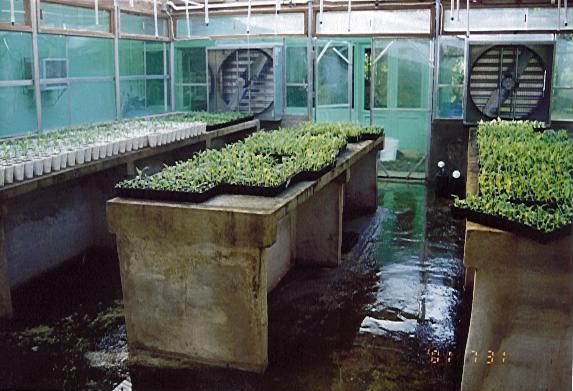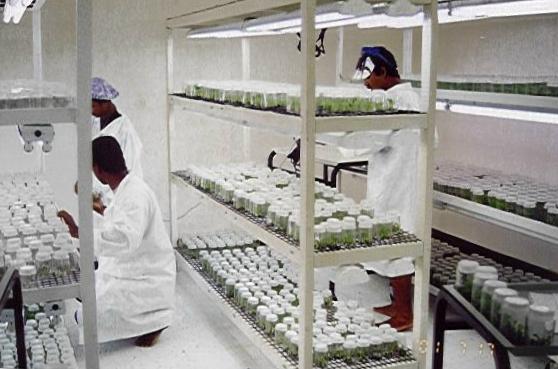Abstract
Two varieties of vitamin A rich bananas (Musa troglodytarum) with local names 'Usr Kulasr'
and' 'Usr Kulondol' were micropropagated. M. trpglodytarum is an endangered species, probably
endemic to the Federated States of Micronesia (FSM).ln vitro propagation technique was applied
to mass propagate and save this nutritionally important germplasm from extinction.
Both varieties grew better on half-strength Murasbige and Skoog (MS) medium. Shoot tip explants
needed four to five months to reach multiplication stage. Prolonged incubation on MS medium
containing 6-benzylaminopurine at 0.5 to 1.0 mg L-1 and 0.5 mg L-I indole-3-acetic acid caused
shoot multiplication. Micro-shoots profusely rooted on half-strength MS basal medium.
Acclirnatisation of transplanted plantlets in a controlled-environment greenhouse resulted in 90-
94% survival. Only ab<;>ut 60% of ex vitro rooted plants were acclimatised to field condition.
Key words
Conservation, tissue culture, Micronesia, vitamin a deficiency, Usr Kulondol, Usr Kulasr.
Introduction
Banana is the largest fruit crop in the world. It is the 4th largest food crop in the world and affects
lives of 400 million people (Vuylsteke, 1989; Moffat, 1999). Most of the people depending on
bananas live in tropical and subtropical Mrica, Asia and Oceania and are resource poor. Banana is
a staple food for the people of the Federated States of Micronesia (FSM) and other small tropical
islands.

Vitamin A deficiency syndrome is rife in all the four states in the FSM (Sowell et al., 2000). Two
varieties of bananas with upright bunches (Musa troglodytarum ) which were used as baby food in
the FSM with local names '.Karat or Usr Kulasr" and".'Uht en Yap or Usr Kulondol'. were analysed
for their"vitamin A contents. This study revealed that Karat banana has 160 (RE) l100g and Usr
Kulasr over 400 (RE) II OOg respectively (Engleberger,2001. Engleberger, personal colIUI1unication).
These bananas (probably endemic to the FSM) are endangered because of the deforestation (loss
of habitat) and lack of organised cultivation. With the discovery of the potential of these bananas
in the FSM. Micropropagation has the potential f()r rapid cloning of plants. To the best of our
know ledge there are no reports on micropropagation of these banana varieties. Therefore, tissue
culture technique was applied to rapidly multiply these valuable gennplasms to facilitate large
scale planting leading to their conservation ill vitro and in situ.
Materials and Methods

Plant material and Culture Establishment
Two varieties of M. troglodytanun with local names 'Usr Kulasr' and' 'Usr Kulondo)' were used in
this study- Healthy sword suckers (40-50 cm) were collected from farms in Kosrae.'The conus
were cleaned with running tap water and trimmed to 3 -4 cm3 pieces enclosing the shoot apical
meristem. These pieces were surface sterilised with 100% (v/v) Clorox for 10-15 minutes, trimmed
to 1-1.5 cm3 size enclosing the meristem, further treated with 0.1% (w/v) mercuric chloride solution
for 3-5 minutes followed by 4-5 rinses with sterile water to complete the disinfection process.
Shoot tips (3-4mm3) derived from the disinfected tissue were used as the explants. Each treatment
included 5 explants in culture establishment phase and the experiments were repeated only once
because of shortage of suckers. Further experiments (stage II and stage Ill) were repeated three
times with 20 or more replicates. MS medium (Murashige and Skoog 1962) supplemented 6-
benzylarninopurine (EA), indole-3-acetic acid (IAA) and 6-yy-dimethylallylamino) purine (2iP)
was used in this study. Basal medium was modified with ascorbic acid ( 50 mg L -I) and increasing
thiamin concentration to 1 mg L -I. Medium pH was adjusted to 5.7 before adding agar (6.5 9 L -I ).
Media were sterilised by autoclaving at 1.2kg cm-2pressure and 121°C for 15 minutes. All cultures
were incubated at 26-+2°C with 8 hour photoperiod. Cultures were transferred to fresh media
every 20-25 days.
Shoots (5-8 cm) with 3-4 leaves (with or without roots) were transplanted to potting mix (All
purpose potting mix, Hyponex@, USA) and transferred to controlled environment greenhouse for
acclimatisatjon. This greenhouse used natural light (transparent fiberglass roof- Tuftex, USA).
Temperature was adjusted to 28- 30°C during the day and relative humidity < 90% with misting
and forced air circulation.
Results and Discussion
Aseptic culture establishment
Loss ofexplants due to contamination is a major problemintissu~culture ofba:nanasin Micronesia.
A two-step surface sterilisation procedure was necessary to obtain 90% or more aseptic stage I cultures,
an observation consistent with our earlier results on other banana varieties in Micronesia (Josekutty
et al., 2001). MS medium containing half-strength nutrients supplemented with 1 mg L -I EA and
0.05 mg L -I IAA resulted in the establishment of 90- 94% initial explants. Ascorbic acid at 50 mg
L -I reduced phenolic exudation and subsequent death of explants. Bananas are reported to respond
to low and high salt media but low requirements of plant growth regulators observed in this case
differs from most of the previous reports. Positive effects of antioxidants like ascorbic acid in
reducing phenolic exudation and subsequent browning of explants is well documented in banana
tissue culture (Cronauer and Krikorian, 1986, Vuylsteke, 1989).
Shoot multiplication

Initiation of shoot proliferation in stage I culture needed 130- 150 days. Low concentrations of
EA (I mg L -I) and IAA (0.1 mg L -I) effected satisfactory multiplication (5-6 shoots per cultured
shoot). Addition of 0.5 mg L -1 2iP to the multiplication medium caused proliferation of numerous
creamy short shoots (20-30) but they could not develop into green shoots. Wide variation in the
time needed for the induction of shoot multiplication has been reported for different varieties of
bananas (Josekutty et at., 2001). This variation could be related to the genotypic differences.
Rooting and Acclimatisation
Five to eight can tall shoots with a few open leaves were tested for their rooting potential. All
shoots incubated on half-strength MS medium supplemented with I gL -I activated charcoal
profusely rooted in 8-10 days of incubation. About 94% of Usr Kulasr and 90% of Usr Kulondol
rooted in vitro were successfully established in a greenhouse withcontrol on humidity and
temperature. Result of ex vitro rooting and plantlet establishment in the greenhouse is not
encouraging (Table1 ). Low rate of establishment of micropropagated plants are attributed to poor
organisation at the root-shoot juncture, poorly developed cuticle, underdeveloped vasculature and
fewer stomata. Bananas produce glossy leaves when grown on half strength medium containing
charcoal. Micropropagated bananas nonnally root from the corm thus having a better root-shoot
connection. This may be the reason for the high survival rates of micropropagated bananas in a
proper greenhouse. The poor rooting observed in ex vitro rooting trial (60-70 % ) could be the
reason for their lower rate of establishment in the greenhouse.
Table-1: Effect of in vitro and ex vitro rooting on acclimatisation of M. troglodyttarum varieties.
| Variety of Musatroglodytrarum |
No. of shoots rooted in vitro and transferred |
No. of in vitro rooted plants acclimatised |
No. of shoots transferred for ex vitro rooting |
No. shoots rooted ex vitro and acclimatised |
Usr Kulasr
Usr Kulondol |
96
48 |
90 (93.8%)
43 (89.6%) |
86
40 |
50 (58.1%)
23 (57.5%) |
Acknowledgements
Authors gratefully acknowledge Nena S. Nena, Dirctor, Department of Agriculture, Land and
Fisheries, Kosrae for arranging the operational funds. Kosrae State and College of Micronesia and
College of Micronesia- FSM- Land grant program are acknowledged for providing the facilities.
|
|